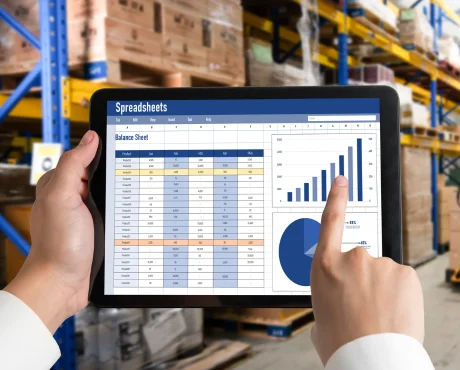Supply chain experts understand this reality well: Disorder isn’t an exception—it’s standard practice. Invoices come in as PDFs, purchase orders are sent by email, and somewhere in the office, someone is manually copying and pasting information into a system that simply isn’t built for it.
This is the everyday situation for many large-scale industries. The go-to systems—ERPs, CRMs, and various marketplaces—were designed for neatly organized data. Yet today, over 80% of the data flowing through supply chains is unstructured.
The disconnect between what your system can process and what your partners deliver is where value slips away. The challenges of managing unstructured data are, however, possible to overcome with effective strategies and the use of the right software. Let’s explore those challenges and strategies.
The Digital Data Deluge in Supply Chains

Modern supply chains operate as complex ecosystems interlinking multiple processes—from procurement and production to distribution and customer service. With the rapid adoption of digital technologies, the volume of data generated every minute is staggering. However, a major chunk of this data is not well-organized. Unlike structured data neatly stored in databases, unstructured data comes in varied formats without a predetermined model, making it difficult to analyze and harness.
For example, for a global manufacturer whose supply chain spans continents, every shipment, customer feedback, maintenance report, and even casual social media mention contributes to a growing mass of unstructured data. The challenge is twofold: not only does this data require sophisticated tools for analysis, but its sheer volume can conceal hidden costs that affect decision-making and operational efficiency.
The Hidden Costs Lurking in Unstructured Data Analysis
1. Increased Operational Inefficiencies

One of the most immediate costs associated with unstructured data processing is operational inefficiency. Consider the following scenarios:
- Manual Processing: Employees spend countless hours manually sifting through emails, scanned documents, and reports. This leads to human error and diverts valuable time from more strategic tasks.
- Delayed Decision-Making: The inability to quickly extract actionable insights delays critical decisions. For example, unrecognized maintenance issues detected in sensor data can lead to production downtime, a costly consequence in any supply chain.
The hidden cost here is the time wasted and the lost revenue opportunities stemming from delayed responses and inefficient operations.
2. Suboptimal Inventory Management
Inventory is the lifeblood of any supply chain, yet unstructured data can complicate its management. For instance:
- Demand Forecasting Errors: Unstructured data from customer reviews, social media, or weather reports can explain fluctuating demand. However, if these signals are ignored or misinterpreted, companies risk overstocking or stockouts, which incur hefty costs.
- Inefficient Replenishment Cycles: Supply chain managers might fail to synchronize inventory levels with actual demand without real-time insights derived from unstructured data, leading to missed sales or excessive storage costs.
3. Compromised Quality Control
Quality control is paramount in supply chain management. Unstructured data often contains critical information regarding product quality:
- Supplier Performance: Feedback from various sources, including emails and incident reports, can highlight recurring issues with specific suppliers. Yet, without a proper mechanism to analyze this data, companies might continue to incur costs due to subpar materials and production delays.
- Customer Complaints: A wave of unstructured data from customer service interactions can signal quality issues. Ignoring these signals damages brand reputation and can lead to expensive recalls or warranty claims.
4. Missed Opportunities for Innovation
Every piece of data represents an opportunity for innovation. For instance, advanced analytics can reveal patterns that inspire new product lines or uncover untapped market segments. However, failing to integrate and analyze these insights translates into missed opportunities that can set competitors apart.
Also Read: How Data-Driven Procurement Transform Supply Chain Management for the Modern Era
Strategies to Turn Unstructured Data into a Gold Mine
![]()
While the hidden costs of unstructured data in supply chains are significant, they are far from impossible. With a forward-thinking approach, businesses can transform these challenges into strategic advantages.
1. Embracing Advanced Analytics and AI
Artificial Intelligence (AI) and machine learning (ML) revolutionize the manual processing of unstructured data. These technologies can automatically decipher vast datasets, extracting real-time key insights. By integrating AI-driven platforms into supply chain management systems, companies can:
- Predict Disruptions: By analyzing sensor data and maintenance logs, AI algorithms can forecast equipment failures before they occur, enabling proactive maintenance.
- Enhance Demand Forecasting: Machine learning models can correlate seemingly unrelated data points—like weather patterns and social media sentiment—to predict market demand more accurately.
A forward-thinking supply chain strategy leverages AI for unstructured data analysis and as a core component of strategic planning. The benefits include reduced downtime, improved inventory management, and a significant boost in overall efficiency.
2. Investing in Data Integration Platforms
The real challenge with unstructured data is not its volume but its diversity. Investing in robust data integration platforms can help consolidate disparate data sources into a single, coherent system. These platforms facilitate:
- Real-Time Data Synchronization: This enables a unified view of operations across various channels and processes.
- Streamlined Reporting: Automated dashboards can provide decision-makers with insights at a glance, removing the bottleneck of manual data processing.
- Improved Collaboration: Integrated data platforms break down silos within organizations, fostering collaboration between departments—from procurement and logistics to marketing and customer service.
Also Read: How Cost Estimating Software Gives You Costing Clarity and Fuels Efficiency
How Cost It Right Solves The Problem Of Unstructured Data in Manufacturing

Cost It Right is a comprehensive platform for precision cost management that streamlines your operations and transforms unstructured data into actionable insights. Here’s how it tackles the messy challenge of unstructured data in supply chains:
- Centralized Data Repository: Cost It Right brings all your data together into one unified hub. By seamlessly integrating information from various sources like ERPs, CRMs, and more, it ensures you have a single, reliable view of your costs. This streamlined approach simplifies data access, enhances accuracy, and empowers you to make faster, better-informed decisions for improved financial management.
- Seamless Integration: Designed to integrate with your existing systems and processes, Cost It Right combines data from ERPs, CRMs, and other sources into one central hub. This unified approach ensures that no matter where your data comes from, it’s accessible and ready for analysis.
- Empowered Decision-Making: By converting chaotic data into clear, organized information, Cost It Right helps supply chain managers make smarter, faster decisions. With accurate cost analysis and reporting, they can optimize financial strategies, forecast demand more precisely, and manage inventory more effectively.
- Enhanced Profitability: Ultimately, Cost It Right drives down operating costs by automating data processing and reducing manual work. This not only streamlines your operations but also enhances profitability—turning the hidden costs of unstructured data into an opportunity for growth.
Conclusion
The message for supply chain executives and industry leaders is clear: unstructured data is not just an operational burden—it’s a hidden cost that, if left unchecked, can derail even the most robust supply chain. However, companies can turn this challenge into a powerful competitive advantage by embracing advanced analytics, cloud-based solutions, and a data-driven culture.
Now is the time to invest in Cost It Right, which will help you manage unstructured data and unlock its hidden value. Transform your supply chain from a reactive, costly system into a proactive, innovation-driven engine that propels your business forward in a world where every second counts and every insight matters.





